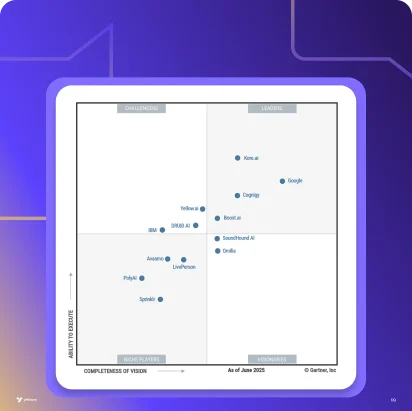Summary
Voice bots and IVRs have caused a seismic shift in customer service globally. Voice bots leverage AI and NLP to provide dynamic, conversational interactions, while traditional IVRs use pre-recorded messages and menu-based navigation. Both technologies are becoming increasingly important in call centers and customer engagement. The global market for these technologies is significant and expected to proliferate over the next five years. However, many think of them the same, confusing them about their distinct advantages. Businesses must know the difference to implement the suitable solution.
In this blog, readers can expect an in-depth exploration of voice bots and IVRs. We will define both technologies, highlight the main distinctions, and discuss their benefits. The blog will also cover practical applications and use cases, guiding you in choosing the most suitable technology for your business. It will give a peep into the future trends and the evolving role of voice bots and IVRs in customer service. This comprehensive guide will help businesses understand the advantages of voice bots vs. IVRs and make informed decisions.
Related must-reads:
- AI Voice Bot – The complete guide to voice chat
- What are voice bots and their use-cases for different industries?
- Voice AI – What is it and benefits of voice AI for business
- How voice bots are transforming customer service in 2024?
- Voice bot in banking: Transforming customer interactions in 2024
Introduction to voice bots and IVRs
Voice bots and IVRs are pivotal in modern customer service, offering unique functionalities and benefits. Understanding their definitions and basic functionalities is crucial for leveraging them effectively in business operations.
Definition of voice bots
A voice bot is an advanced AI-driven software application designed to interact with users through spoken language. It harnesses technologies such as Automatic Speech Recognition (ASR), Natural Language Processing (NLP), and Text-to-Speech (TTS) to understand and respond to voice commands.
Basic functionalities of voice bots:
- ASR: Converts spoken language into text, allowing the voice bot to understand user input.
- NLP: Analyzes the text to comprehend user intent and context, enabling the bot to respond appropriately.
- Text-to-Speech (TTS): Converts text responses back into spoken language, allowing the bot to communicate verbally with users.
- Contextual understanding: Maintain context during conversations, leading to more natural and fluid interactions.
- Self-service capabilities: Without human assistance, they let users check account balances, make bookings, and answer FAQs.
For example: A customer connects with a retail brand’s voice bot and asks, “Where is my package?” The bot promptly provides the latest tracking information.
Definition of IVR
Interactive Voice Response, or IVR, is an automated telephony technology that enables callers to use voice commands or touch-tone keypad inputs to engage with a computer-operated phone system. IVR allows users to access information, make requests, and navigate menus without speaking to a live agent. They can respond with pre-recorded messages or dynamically generated audio to guide users on how to proceed.
Basic functionalities of IVR:
- Automatic Speech Recognition (ASR): Converts spoken language into text, allowing the IVR system to understand user input.
- Dual-Tone Multi-Frequency (DTMF): Enables the system to interpret touch-tone keypad inputs from callers.
- Database integration: Allows the IVR system to access relevant data to provide personalized information or perform transactions.
- Call routing: Directs callers to the most appropriate department or agent based on their input or request.
For example: A bank customer calls the bank’s IVR, navigates through the menu by pressing keys, and successfully transfers funds without human intervention.
Key differences between voice bots and IVRs
As a business owner, you must understand the key differences between voice bots and IVRs to pick the right technology for your customer service needs. Voice bots and IVRs are pivotal technologies that streamline interactions between businesses and their customers, but they serve distinct purposes and offer different levels of interaction complexity. This comparison will clarify their functionalities, use cases, and the overall impact on user experience, helping you decide which technology aligns best with your business needs.
| Feature | Voice Bots | IVRs (Interactive Voice Response) |
| Technology | Utilize AI and NLP for dynamic, conversational interactions. | Rely on pre-recorded messages and DTMF signaling for menu-based interactions. |
| Functionality | Capable of understanding complex queries and providing personalized responses. | Handle simple, repetitive tasks like call routing and basic information retrieval. |
| Use cases | Suited for complex inquiries and personalized interactions, such as technical support, product recommendations, and detailed customer service. Example: An insurance company’s voice bot can interpret detailed customer queries about policies and provide tailored responses. | Best for straightforward tasks like call routing, basic information provision, account balance inquiries, and password resets. Example: A banking IVR might direct a caller to press specific keys for account balance or transaction history. |
| User experience | Offers natural, conversational interactions that mimic human dialogue, enhancing user engagement and satisfaction. Example: A customer might ask a voice bot, “What are the coverage options for my car insurance?” and receive a detailed, personalized explanation that adapts to follow-up questions and clarifications. | Provides a structured, menu-based interaction which can feel robotic and impersonal. Example: A caller might navigate an IVR of a hotel’s customer care by pressing specific keys to report a lost membership card, following a clear but limited set of choices that do not adapt to nuanced or complex queries. |
| Adaptability | Can adapt responses based on context and learn from interactions. | Operate strictly within their programmed responses without the ability to adapt. |
| Emotional intelligence | Capable of detecting user emotions through tone and context to tailor responses. | Lack emotional detection capabilities, responding uniformly regardless of user sentiment. |
| Interactivity | Handles follow-up questions and maintains context throughout interactions. | Limited to linear interactions based on predefined choices without flexibility for follow-ups. |
| Emotion recognition | Analyze vocal cues to detect emotions and modify responses accordingly. | Do not support emotion recognition, providing standard responses regardless of user mood. |
| Self-service capabilities | Facilitate effective self-service options, allowing customers to solve problems or access services without human assistance. | Primarily provide information or perform specific tasks based on preset menus. |
| Multilingual support | Support multiple languages, enhancing accessibility for a diverse customer base. | Often limited in language support, potentially requiring separate setups for different languages. |
Benefits of voice bots vs IVRs
Voice bots and IVRs are indispensable tools in modern customer service, each with unique advantages. You must grasp their benefits to help your business choose the right solution to enhance customer experience and operational efficiency.
Benefits of voice bots
- Enhanced customer engagement and satisfaction
Voice bots are incredible at improving customer engagement and satisfaction by offering a more interactive and human-like experience. These AI-powered assistants are intelligent enough to understand natural language, respond accurately, and even detect the users’ emotional cues and sentiments. Such nuanced responses make customers feel heard and valued.
Personalize interactions with voice automation and boost CSAT by 40%
- Ability to handle complex interactions and provide personalized responses
Voice bots are adept at handling complex queries and providing tailored responses. Harnessing the advanced AI and machine learning algorithms, they excel at analyzing customer data and past interactions to offer relevant solutions and recommendations. This capability ensures that customers receive precise, context-aware assistance, enhancing their overall experience.
- Real-time analytics and continuous learning
Voice bots steal the show with their ability to deliver real-time analytics and continuous learning. They gather and analyze data from each interaction, giving beneficial insights into customer behavior and preferences. This data-driven approach allows businesses to continually improve their services, making voice bots invaluable for dynamic and responsive customer support.
Benefits of IVRs
- Cost-effective for simple queries and routing
IVRs, or Interactive Voice Response systems, are highly cost-effective for handling simple queries and routing calls. They utilize pre-recorded messages and menu-driven prompts to guide customers through basic inquiries and direct them to the appropriate department or resource. This efficiency reduces the need for human intervention and operational costs.
- Reliable for high-volume, straightforward interactions
IVRs are known for their reliability in managing high volumes of straightforward interactions. They are designed to handle multiple calls simultaneously without compromising service quality. This makes them ideal for businesses that receive a massive volume of routine inquiries, ensuring consistent and uninterrupted service.
- Easy integration with existing phone systems
Another significant advantage of IVRs is their ease of integration with existing phone systems. Most IVR solutions are compatible with various telephony infrastructures, allowing for seamless deployment and minimal disruption. This compatibility ensures that businesses can quickly implement IVR technology and start reaping its benefits without extensive modifications to their current systems.
Choosing between voice bots and IVRs
Deciding whether to implement voice bots or IVRs hinges on specific business needs, customer interaction complexity, and financial considerations. Here’s what to keep in mind:
Business needs and goals
Evaluate the complexity of customer inquiries your service handles. Opt for voice bots if you require handling detailed, personalized interactions through natural language processing, which facilitates deeper customer engagement. IVRs, conversely, are ideal for straightforward tasks like call routing or providing preset answers to common questions. Consider both the initial investment and the potential long-term ROI. Voice bots, though initially costlier, may offer greater savings and efficiencies over time due to their sophisticated capabilities and customer satisfaction enhancements. IVRs can be more budget-friendly and are effective for managing high volumes of simple queries.
Customer preferences and behavior
Understanding your customers’ preferences is crucial. Market research can reveal whether your audience favors the advanced interaction provided by voice bots or the direct approach of IVRs.
Different scenarios may highlight the superiority of one technology over the other. For instance, voice bots excel in environments where personalized, complex customer interactions are common, such as in financial services or healthcare. In contrast, IVRs are highly effective in scenarios requiring high-volume, repetitive task handling, such as in telecommunications or utilities. Understanding these specific use cases can help businesses leverage the right technology for optimal performance.
Voice bots and IVRs in customer service
Voice bots and IVRs play pivotal roles in enhancing customer service. Understanding their impact in various customer service scenarios can assist enterprises in optimizing their operations and improving customer experiences.
Effectiveness in call centers
Voice bots and IVRs significantly streamline call center operations by automating routine tasks. Voice bots can handle complex customer queries without human intervention, reducing agents’ workload. IVRs efficiently route calls to the appropriate department, ensuring customers are swiftly connected to the right resources. This automation reduces wait times and improves overall efficiency.
Both technologies enhance customer satisfaction and engagement, albeit in different ways. Voice bots provide personalized, conversational interactions that make customers feel valued and understood. This tailored approach builds and promotes a robust connection between the customer and the business. IVRs ensure that customers receive prompt assistance with quick and efficient call routing, which is crucial for maintaining high satisfaction levels in high-volume environments.
Customer engagement
Voice bots are famed for delivering personalized interactions. They capitalize on advanced AI to understand customer context and history, offering relevant solutions and recommendations. This capability allows for a more human-like and engaging experience, catering to individual customer needs and preferences, which enhances loyalty and satisfaction.
IVRs are experts at efficiently routing calls. IVRs guide customers to the most suitable department or service with minimal hassle by providing a menu of options. This efficiency reduces call handling time and ensures that customers quickly reach the most qualified agent to address their needs, improving the overall service experience.
Future trends and developments for voice bots and IVRs
AI and voice technology advancements are set to transform voice interfaces into indispensable tools for customer service and personal productivity. Neural voice technology makes it easier for multilingual AI helpers to create, and using deep learning models, neural voice makes AI helpers sound more human. Advanced NLP will enable voice bots and IVRs to understand human speech more effectively, leading to heightened natural, human-like conversations. Voice interfaces will provide multimodal interactions, integrating visual displays, touch interfaces, and augmented reality. Voice bots will enhance personalization and proactivity by learning user preferences and habits and providing highly personalized recommendations and assistance.
Emotional intelligence will be developed, enhancing user trust and engagement. Voice interfaces will become ubiquitous across devices, integrating with smart home systems and appliances for a unified voice-driven experience. Advanced analytics will help optimize IVR menus and enhance customer experience. Multilingual support will be offered, catering to diverse customer bases and improving accessibility.
Predictions for the evolution of voice bots and IVRs by 2030 and beyond indicate a significant shift towards more sophisticated, AI-driven systems capable of handling complex customer interactions. Voice bots will increasingly replace traditional IVR systems, offering more natural and personalized experiences through advancements in natural language processing and neural voice technology. Nevertheless, forecasts also indicate IVRs to evolve to become more intuitive and user-friendly, leveraging AI to predict and respond to customer needs more accurately. The adoption of cloud-based solutions will make these technologies more scalable and accessible to businesses of all sizes. The global voice bot market is projected to reach approximately $98.2 billion by 2027, growing at CAGR of 18.6%. This boom will be fueled by the soaring demand for omnichannel customer service and the integration of voice technology across various platforms and devices. Stratistics MRC predicts the global IVR market will reach $9.9 billion by 2030, rising 8.8%.
Voice Bots vs. IVR: Key takeaways for strategic decisions to enhance customer service
As we wrap up our discussion, it’s clear that both voice bots and IVRs hold valuable places in customer service ecosystems, each with its strengths.
Voice bots shine in managing complex, nuanced interactions, leveraging advanced AI to offer personalized responses and adapt over time through real-time analytics. They can significantly reduce the need for extensive human agent teams by handling intricate customer requests autonomously, elevating automation to new heights.
On the other hand, IVRs efficiently manage high call volumes, providing cost-effective solutions for straightforward tasks such as basic inquiries and call routing. They facilitate essential self-service options and can effectively direct customers to the appropriate support channels, but they lack the capability to engage in complex problem-solving that voice bots provide.
As you consider the future of your customer service, reflect on the unique demands of your business. Integrating voice bots could dramatically transform your service delivery, offering a deeper, more intuitive customer interaction. IVRs might improve efficiency to an extent by offering basic self-serve, voice bots can elevate your service strategy to new heights, by ensuring scalability, unmatched efficiency, cost reductions, and most importantly, boost in customer satisfaction through hyper-contextual and resolution-focused natural conversations.
Your decision should align with overarching business goals—whether enhancing immediate efficiencies or investing in long-term customer satisfaction. Evaluate your needs, and let the technology you choose propel your customer service into a new era of excellence.






















